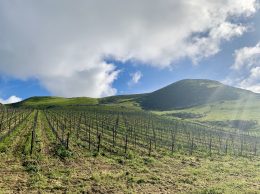Wine drinkers open their wallets again for pricier bottles
IN THIS ARTICLE
- Columns Topic
- Tom Bronzini Author
By Tom Bronzini Friday, March 20th, 2015
Measured optimism about the region’s wine industry was a theme that ran through the Central Coast Insights wine symposium in Paso Robles on March 12.
An improving economy, consumers moving up to higher priced wines, better profits and plans to increase case production were among the positive news. Water availability, a surplus of bulk wine from three big harvests and the need to explain the region’s diversity of grape varieties to consumers outside of California are concerns for the industry.
About 135 professionals from vineyards, wineries, financial and related fields gathered for the daylong event, organized by the Wine Industry Symposium Group. Here are some noteworthy items from their discussions:
• Consumers are trading up to higher priced wines at retail outlets, according to Nielsen data. Brian Lechner, vice president of professional services at Nielsen, said off-premise wine sales grew only 1 percent last year and there was almost no price appreciation, but shoppers bought a lot more wine in the $12 to $20 price range. Sales volume in that range grew 7.8 to 9.1 percent while volume in all segments below $9 a bottle declined. The growth at the higher end lines up with the Central Coast’s strengths, he said.
Central Coast producers make many wines priced well above $20 a bottle, most of it sold direct to consumers, a much smaller market than the wholesale market.
• Fifty-five percent of wine producers in a survey concentrated mainly on the Central Coast said their profits went up in 2014 compared to the previous year, and 18 percent said they were down. Sixty percent plan to raise case production, according to the survey by the Silverado Group.
In the same survey, 50 percent said they will raise prices in 2015. The largest group, 25 percent, said the boost would be a modest 2 percent, and only 8 percent planned increases of 10 percent or above.
“It’s been hard at retail to raise bottle prices,” said David Freed, chairman of the Silverado Group, who presented the survey results. “As a consequence some of the margin at the winery level and maybe at the distributor level has been squeezed.”
When asked to list the top five strengths of Central Coast wines, an overwhelming 75.9 percent in the survey rated quality/value as No. 1. The survey had 62 responses, 90 percent of them grape growers, winery personnel or both, and the others from banking or consulting fields.
• A nationwide Nielsen survey conducted in January asked people which of several growing regions were of most interest to them. The Napa Valley was No. 1, followed closely by the Central Coast, ahead of Italy, Australia, Spain, Argentina, Washington and Oregon. “So there is a lot of opportunity to reach out to people, to explain to them what Central Coast is all about and why it offers quality wine that may be different from what other areas have to offer,” Lechner said.
• In the Silverado Group survey, respondents ranked water supply issues and the slow economic recovery among their top worries — both at 4.19 on a scale of 5. Matt Turrentine, who has studied groundwater issues at GrapeVine Capital Partners, said the Paso Robles Groundwater Basin’s shortages are solvable, especially when compared to the Central Valley’s water issues. He said estimated groundwater overdrafts of 3,000 to 6,000 acre feet per year in the Paso Robles basin during the drought look modest compared to overdrafts of more than 250,000 acre feet per year projected in Madera County. It would be best for Paso Robles to work out its own water management plan rather than have one imposed by the county or state, he said.
• There is an excess of bulk wine available in the Central Coast after three years of bountiful grape harvests, putting downward pressure on prices. Producers who have not moved their 2012 wines are in a tough market.
• A panel of Central Coast vintners discussed whether the region’s huge diversity of grape varieties is a blessing or a curse. In Santa Barbara County, for example, 57 varieties are grown. Establishing an identity for the region is often cited as a challenge.
Karen Steinwachs, winemaker at Buttonwood Farm in the Santa Ynez Valley, said she embraces the diversity. “I think the world is awash in chardonnay and cabernet and I think there’s a lot of people out there looking for something different,” she said.
Tim Snider, president of Fess Parker Winery, said distributors resist carrying lesser known wines. “What we’ve found is that the more that we can drill down and market into specific AVAs that are known for specific varietals, the better off we’re going to be,” he said.
• Contact Tom Bronzini at [email protected].










